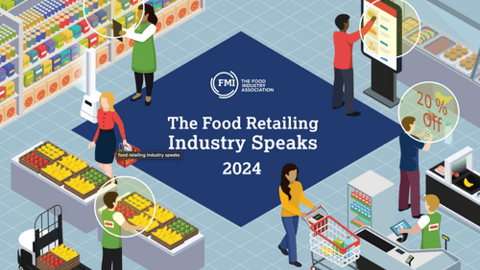Grocery Shoppers Stay Focused On Price Despite Easing Inflation
Consumers are augmenting their grocery shopping habits as they work to control their spending levels heading into the fall, according to a new survey from FMI - The Food Industry Association.
Conducted with The Hartman Group, the U.S. Grocery Shopper Trends 2024: Return To Routine report found that despite continued concerns about inflation, 83% of survey respondents feel they have at least some control over their grocery spending.
“Shoppers report that one of the few parts of their household budgets they can control is their grocery spending and that through taking advantage of deals, promotions or shopping around, they continue to find value,” said Leslie G. Sarasin, president and CEO of FMI. “While we understand shoppers’ concerns about the price of food on store shelves, our U.S. Grocery Shopper Sentiment Index shows consumers appreciate the ability to find value in their grocery shopping and continue to enjoy grocery shopping, a trend we expect to continue as food inflation cools.”
While price remains top of mind with most consumers, the FMI survey found that U.S. grocery shoppers now voice somewhat less concern about food affordability. Compared to the previous year, grocery shoppers now are less likely to worry about having enough money to pay for the food they need (39%, down from 42%).
Concern with retail food affordability is far higher among shoppers with incomes below $35,000 (43%) than among those earning above $100,000 per year (21%).
FMI also pointed to data from the U.S. Department of Agriculture (USDA) that found inflation for most food categories fell below historical averages in the first half of 2024. The USDA also projects food-at-home prices will increase by only 1% this year, while next year’s forecast dips below this benchmark significantly to a 0.7% anticipated increase for 2025.
Concerns about prices have also kept "value" top of mind and opened new opportunities for retailers to expand their store brand assortments. In the survey, 79% of shoppers said getting a good value is a top or high priority for them, and most say it's even more important than a year ago.
Shoppers continue to say they're looking for deals and adjusting their mix of food stores, products, and brands to manage the changed price landscape. While they remain unusually intentional about their value-seeking tactics, they remain open to paying more for convenience, quality, and community good.
Consumers also said their primary grocery store does an excellent job meeting their needs, with 79% of respondents saying getting a “good value” when grocery shopping is a top priority.
Shoppers report their average weekly household grocery spend has held steady during the past 18 months ($163). In addition, 63% of shoppers say they continue to look for deals and adjust their mix of food stores, products, and brands to manage their expenses.
Other notable findings of the report include:
- More than 4 in 10 shoppers with household incomes under $75,000 report they buy fewer food items and more private label brands.
- Shoppers rate their primary store 8.0 out of 10 in terms of meeting their needs.
- 65% of shoppers noticed higher-than-normal temperatures this summer, with only 9% associating food shortages with the extreme weather.
- 69% of consumers say they are very or extremely concerned with retail food inflation.




